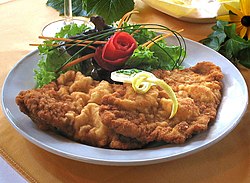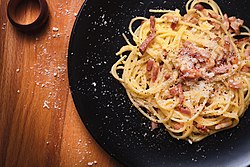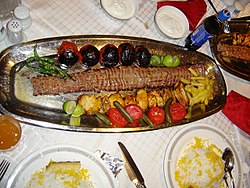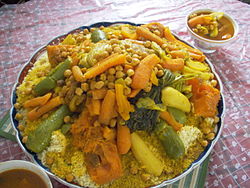
A national dish is a culinary dish that is strongly associated with a particular country. [1] A dish can be considered a national dish for a variety of reasons:
Contents
- By country
- A
- B
- C
- D
- E
- F
- G
- H
- I
- J
- K
- L
- M
- N
- O
- P
- Q
- R
- S
- T
- U
- V
- Y
- Z
- Latin American dishes
- Gallery
- Drink
- National drinks
- See also
- References
- It is a staple food, made from a selection of locally available foodstuffs that can be prepared in a distinctive way, such as fruits de mer , served along the west coast of France. [1]
- It contains a particular ingredient that is produced locally, such as a paprika grown in the European Pyrenees. [1]
- It is served as a festive culinary tradition that forms part of a cultural heritage—for example, barbecues at summer camp or fondue at dinner parties—or as part of a religious practice, such as Korban Pesach or Iftar celebrations. [1]
- It has been promoted as a national dish, by the country itself, such as the promotion of fondue as a national dish of Switzerland by the Swiss Cheese Union (Schweizerische Käseunion) in the 1930s.
National dishes are part of a nation's identity and self-image. [2] During the age of European empire-building, nations would develop a national cuisine to distinguish themselves from their rivals. [3]
Some countries such as Mexico, China or India, because of their diverse ethnic populations, cultures, and cuisines, do not have a single national dish, even unofficially. [2] Furthermore, because national dishes are so interwoven into a nation's sense of identity, strong emotions and conflicts can arise when trying to choose a country's national dish.































